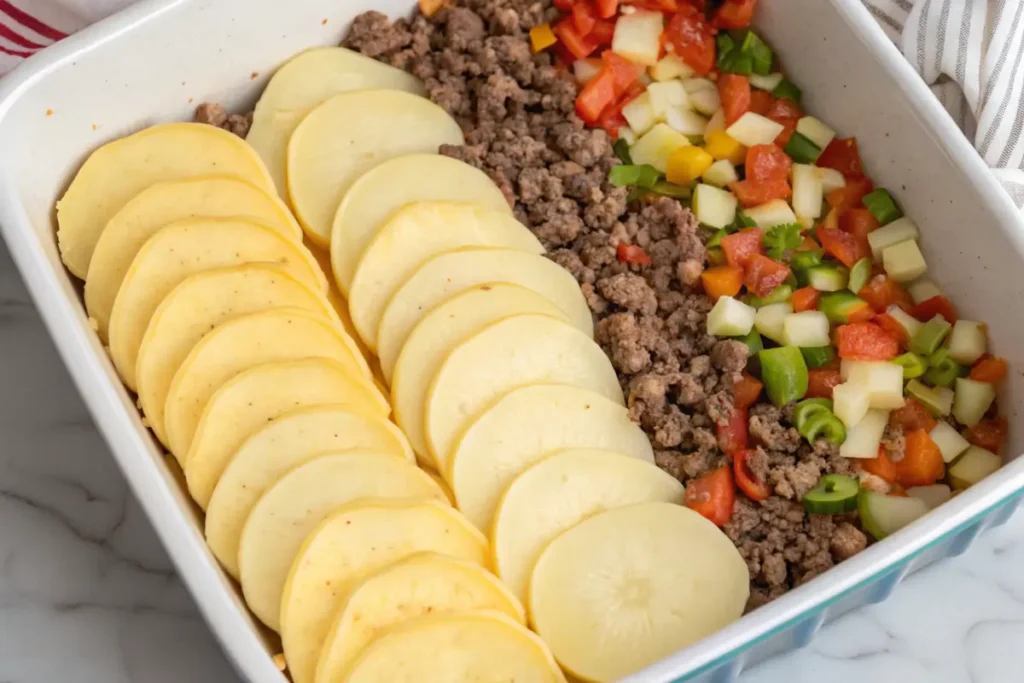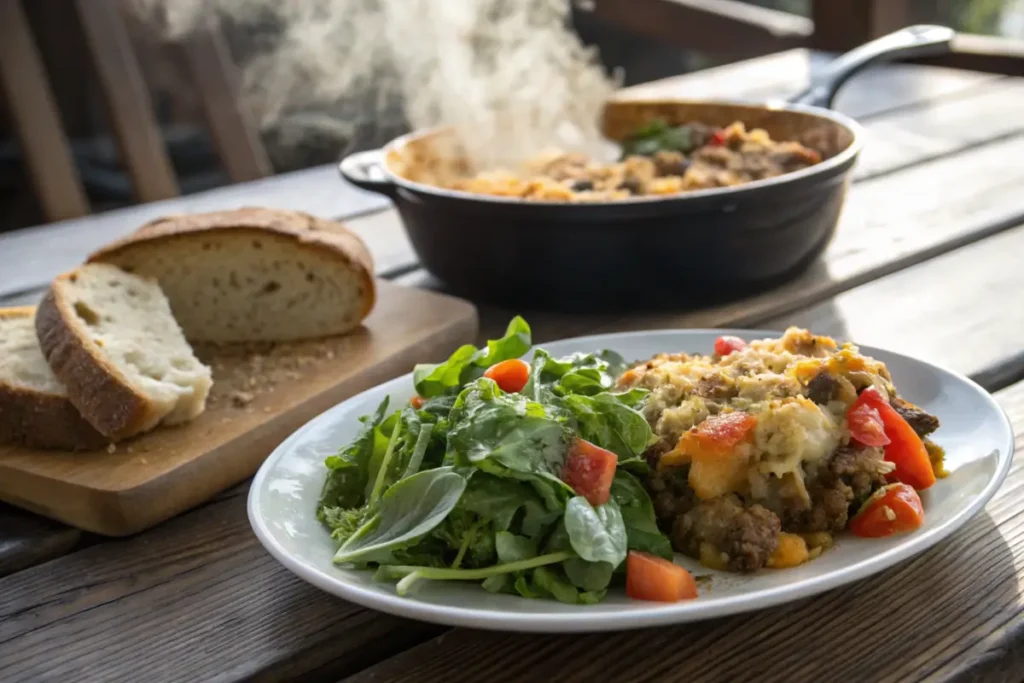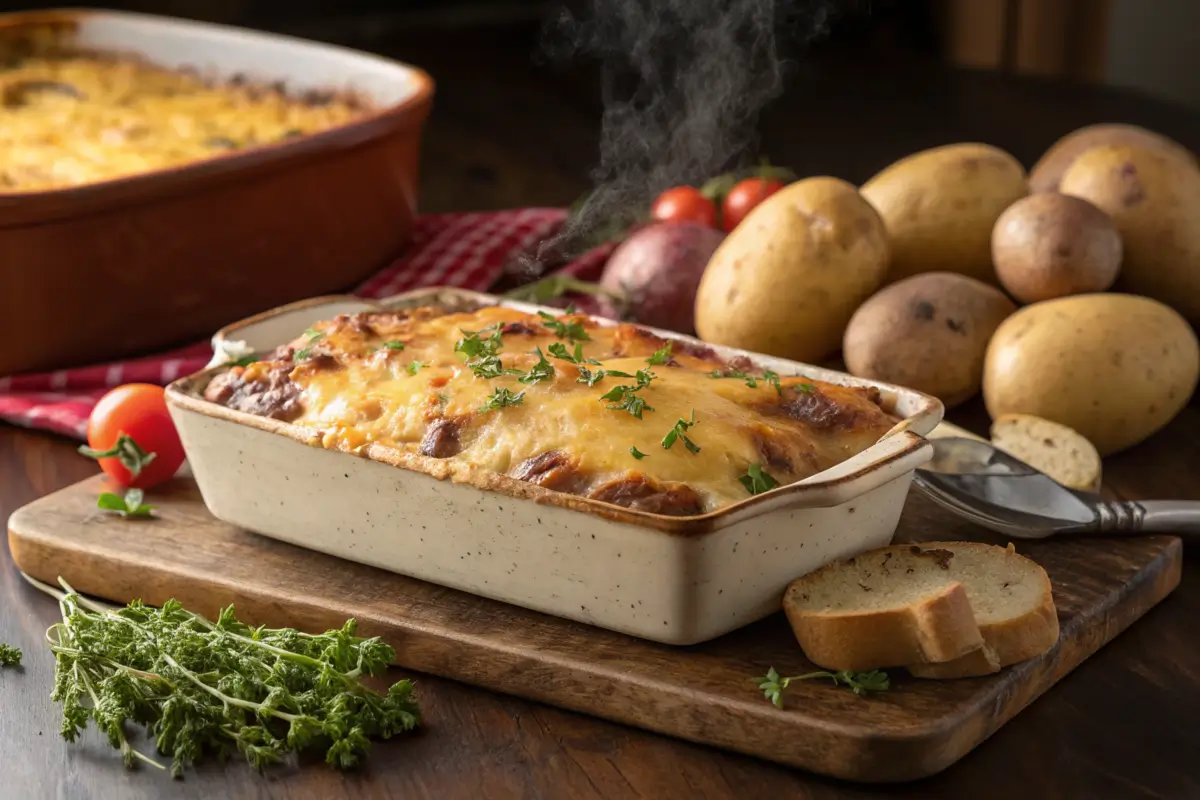When it comes to hearty, soul-warming dishes, few meals can rival the simplicity and satisfaction of a hobo casserole. This timeless comfort food combines easy-to-find ingredients, rich flavors, and a nostalgic cooking method that feels like a warm hug on a chilly evening. Whether you’re whipping it up for a family dinner, preparing it for a camping trip, or embracing its cozy vibes during fall, this dish never disappoints.
In this article, we’ll explore everything you need to know about the hobo casserole, including its history, ingredients, variations, and step-by-step instructions to make it a success. You’ll also find helpful tips, creative ideas, and answers to commonly asked questions to elevate your cooking experience. Ready to dive in? Let’s get started!
What is Hobo Casserole?
What Makes It Unique?
The hobo casserole is no ordinary dish—it’s a one-pan wonder that blends hearty ingredients into a satisfying meal. Unlike more complicated casseroles, this dish thrives on simplicity, using staples like ground beef, potatoes, cheese, and veggies. It’s not just about the food; it’s about embracing the rustic charm and creativity that come with making something so comforting.
A Brief History of Hobo Cooking
The term “hobo cooking” harks back to the Great Depression when resourceful travelers, known as hobos, would cook meals using what they could scavenge or afford. These meals were typically prepared over open fires, often wrapped in foil for convenience. Over time, the concept evolved into what we now call hobo casseroles—a homage to simple, flavorful, and budget-friendly cooking.
Why This Dish Became a Midwest Favorite
You’ll often hear the hobo casserole called a Midwest classic, and for a good reason! Its combination of rich flavors, filling ingredients, and easy preparation make it a hit in the heartland. In a region where casseroles reign supreme, this dish stands out for its adaptability and nostalgic ties to family gatherings and community potlucks.
Ingredients for Hobo Casserole
Main Ingredients and Measurements
To create a delicious hobo casserole, gather the following ingredients:
- 1 pound ground beef: Opt for lean beef to reduce excess fat.
- 4 medium potatoes: Thinly sliced; russet or Yukon Gold work well.
- 1 medium onion: Chopped finely for added flavor.
- 2 cups mixed vegetables: Fresh or frozen; peas, carrots, and corn are popular choices.
- 1 can (10.5 oz) cream of mushroom soup: Adds creaminess to the dish.
- 1 cup shredded cheddar cheese: For a rich, cheesy topping.
- Salt and pepper: To taste.
- 1 tablespoon olive oil: For sautéing the onions and beef.
Substitutions and Add-Ons for Personalization
Feel free to customize your hobo casserole:
- Protein alternatives: Substitute ground beef with ground turkey, chicken, or plant-based meat for a different twist.
- Vegetable variations: Incorporate bell peppers, zucchini, or green beans to suit your taste.
- Cheese options: Swap cheddar with mozzarella, Monterey Jack, or a cheese blend for varied flavors.
- Cream soup alternatives: Use cream of chicken or celery soup if preferred.
Tips for Choosing the Best Ingredients
Selecting quality ingredients elevates your hobo casserole:
- Freshness: Choose fresh vegetables and high-quality meat for optimal flavor.
- Cheese: Shred cheese from a block rather than using pre-shredded varieties to enhance meltability.
- Potatoes: Uniformly slice potatoes to ensure even cooking throughout the casserole.
Step-by-Step Instructions to Make Hobo Casserole
Preparation Steps: Gathering and Prepping Ingredients
Before you start cooking your hobo casserole, ensure all ingredients are prepped:
- Wash and slice potatoes: Clean thoroughly and slice into 1/4-inch rounds.
- Chop the onion: Dice finely to distribute flavor evenly.
- Measure mixed vegetables: If using frozen veggies, thaw them beforehand.
- Preheat the oven: Set to 375°F (190°C) to ensure it’s ready for baking.
How to Layer the Casserole for Optimal Flavor

Proper layering is key to a well-cooked hobo casserole:
- Grease the baking dish: Lightly coat a 9×13-inch dish with cooking spray.
- First layer – potatoes: Arrange sliced potatoes evenly at the bottom.
- Second layer – ground beef: Evenly distribute cooked and seasoned ground beef over the potatoes.
- Third layer – mixed vegetables: Sprinkle vegetables over the meat layer.
- Fourth layer – soup mixture: In a bowl, combine cream of mushroom soup with 1/2 cup of water; pour over the casserole, spreading evenly.
- Top layer – cheese: Finish with a generous layer of shredded cheddar cheese.
Baking and Cooking Tips for Perfect Results
To achieve a perfectly cooked hobo casserole:
- Cover and bake: Cover the dish with aluminum foil and bake for 45 minutes.
- Check for doneness: Remove foil and check if potatoes are tender by inserting a fork.
- Brown the top: Return to the oven uncovered for an additional 15 minutes to allow the cheese to melt and brown slightly.
- Rest before serving: Let the casserole sit for 10 minutes after removing from the oven to set and enhance flavors.
Final Touches Before Serving
Enhance your hobo casserole with these finishing touches:
- Garnish: Sprinkle freshly chopped parsley or chives on top for a pop of color and freshness.
- Serving suggestions: Pair with a crisp green salad or warm bread to complete the meal.
- Storage: Store leftovers in an airtight container in the refrigerator for up to 3 days; reheat thoroughly before serving.
By following these steps, you’ll create a hobo casserole that’s both comforting and delicious, perfect for any occasion.
Creative Variations of Hobo Casserole
Vegetarian and Vegan Options
Transforming the traditional hobo casserole into a vegetarian or vegan delight is straightforward. For a vegetarian twist, replace the ground beef with plant-based meat crumbles or hearty legumes like lentils or black beans. To make it vegan, substitute dairy products with plant-based alternatives: use vegan cheese and a dairy-free cream soup, such as a homemade cashew-based cream of mushroom. Additionally, ensure that any pre-packaged ingredients are free from animal products. This way, everyone can enjoy a comforting hobo casserole.
Adding Unique Flavors: Spices, Herbs, and Toppings
Elevate your hobo casserole by experimenting with various spices and herbs. Incorporate smoked paprika or chili powder into the meat for a smoky kick. Fresh herbs like thyme or rosemary can be layered with the vegetables to introduce earthy notes. For a zesty twist, sprinkle chopped green onions or jalapeños on top before serving. Moreover, consider adding a crunchy texture by topping the casserole with crushed tortilla chips or fried onions during the last few minutes of baking. These enhancements can make your hobo casserole uniquely yours.
Pairing Ideas: Side Dishes and Drinks

Complement your hobo casserole with side dishes and beverages that enhance its hearty flavors. A crisp green salad with a tangy vinaigrette provides a refreshing contrast. Steamed green beans or roasted Brussels sprouts offer additional nutrients and texture. For beverages, consider serving a robust red wine like Cabernet Sauvignon or a chilled amber ale to balance the richness of the casserole. Non-alcoholic options such as sparkling water with a splash of citrus or a glass of iced tea also pair well. These accompaniments can turn your meal into a well-rounded dining experience.
For more delicious recipes, check out our recipe article.
Common Mistakes to Avoid When Making Hobo casserole
Overcooking or Undercooking the Ingredients
Achieving the perfect hobo casserole requires careful attention to cooking times. Overcooking can lead to mushy vegetables and dry meat, while undercooking may result in hard potatoes and underdone beef. To avoid these pitfalls, ensure that all ingredients are cut into uniform sizes for even cooking. Additionally, follow the recommended baking times and check for doneness by inserting a fork into the potatoes; they should be tender yet firm.
Using the Wrong Type of Pan or Dish
Selecting the appropriate baking dish is crucial for a well-cooked hobo casserole. Using a dish that’s too deep can cause uneven cooking, while a shallow dish may lead to spillage. A standard 9×13-inch baking dish is ideal for this recipe, providing ample space for layering ingredients without overcrowding. Moreover, using an oven-safe glass or ceramic dish ensures even heat distribution, resulting in a perfectly baked casserole.
Skipping the Resting Time Before Serving
Patience is key when serving hobo casserole. Skipping the resting period after baking can cause the dish to fall apart upon serving, as the ingredients need time to set. Allow the casserole to rest for at least 10 minutes after removing it from the oven. This brief pause helps the layers firm up, making it easier to slice and serve neat portions, and allows the flavors to meld together for an enhanced taste.
FAQs About Hobo Casserole
Why Is It Called John Wayne Casserole?
The term “John Wayne casserole” is often used interchangeably with hobo casserole, but they have slight differences. Named after the legendary actor, John Wayne casserole typically includes ground beef, cheese, and biscuit layers. While it shares the hearty and layered nature of hobo casserole, it leans toward Tex-Mex flavors with the addition of green chilies and spices. Both dishes are crowd-pleasers, but the hobo casserole shines for its versatility and simplicity.
What Is Hobo Cooking?
Hobo cooking refers to a rustic, resourceful style of preparing meals, popularized during the Great Depression. It’s characterized by cooking simple, hearty meals with limited ingredients, often over an open flame. The hobo casserole is a modern take on this tradition, encapsulating the spirit of resourcefulness while being adaptable to modern kitchens. Whether you’re camping or cooking at home, this dish honors the humble roots of hobo cooking.
What Is a Midwest Casserole Called?
In the Midwest, casseroles are often lovingly referred to as “hotdishes.” These one-dish meals, like hobo casserole, are staples at family gatherings and potlucks. They typically feature a combination of protein, vegetables, a creamy base, and a starchy topping. The hobo casserole stands out among hotdishes for its timeless appeal and adaptability, making it a favorite across generations.
What’s the Difference Between a Stew and a Casserole?
While both stews and casseroles are comforting meals, the primary difference lies in their preparation. Stews are cooked on the stovetop or in a slow cooker, with ingredients simmering in a broth or sauce. Casseroles, like the hobo casserole, are baked in the oven, creating distinct layers and a firmer texture. The baking process often results in a crispy topping, which is a signature feature of many casseroles.
Fun Facts and Personal Anecdotes
Why Hobo Casserole Is a Nostalgic Dish for Many
For many, the hobo casserole evokes memories of simpler times—cozy family dinners, camping trips, and potluck gatherings. Its budget-friendly ingredients and ease of preparation have made it a staple in households across the country. This dish has been passed down through generations, often becoming a family tradition. It’s no wonder the hobo casserole holds a special place in the hearts (and stomachs) of so many.
Interesting Tidbits About Its Origins and Popularity
Did you know the hobo casserole is a favorite among campers? Its simple preparation and minimal cleanup make it ideal for outdoor adventures. Additionally, the dish’s popularity soared during the 1950s when casseroles became a symbol of convenience and comfort in American households. Today, its versatility allows cooks to reinvent it while still honoring its humble beginnings. Whether you’re adding modern twists or sticking to the classic recipe, the hobo casserole continues to bring people together over good food and great memories.
With its rich history and comforting flavors, the hobo casserole is more than just a dish—it’s a connection to the past and a celebration of creativity in the kitchen.
Final Thoughts
Why Hobo Casserole Is a Must-Try Dish
The hobo casserole is more than just a recipe; it’s a timeless classic that brings comfort and joy to any table. Its simplicity, flexibility, and nostalgic charm make it a favorite for family dinners, potlucks, and even camping adventures. With its hearty ingredients and rich flavors, this dish guarantees satisfaction for everyone who tries it. Whether you stick to the traditional version or experiment with your own twist, the hobo casserole never fails to impress.
Share Your Experience and Feedback
Now that you know everything about crafting the perfect hobo casserole, it’s time to give it a try! Gather your ingredients, follow the steps, and create a dish that’s sure to become a new favorite in your household. Don’t forget to share your experience—whether it’s a story, a variation you tried, or feedback on the recipe. Join the conversation and help keep the spirit of this comforting dish alive!

